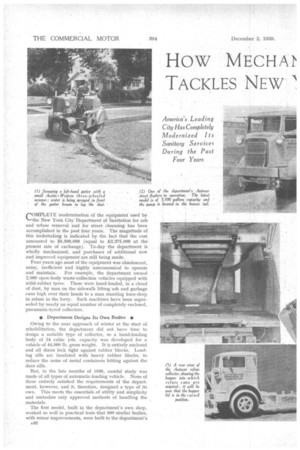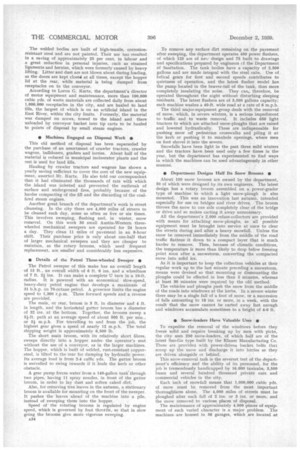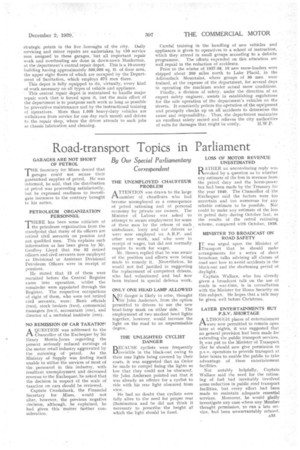How MECHA
Page 34

Page 35

Page 36

Page 37

If you've noticed an error in this article please click here to report it so we can fix it.
TACKLES NEW
America's Leading City Has Completely Modernized Its Sanitary Services During the Past
Four Years
Features of Some of the Main Types of Vehicle and Appliance that are Giving Good Service in
New York
COMPLETE Modernization. of the equipment used by the New York CityDepartment'Of Sanitation for ash and • refuse removal and for street cleansing has been accomplished in the past four years. The magnitude of this Undertaking is indicated bY.the fact that the cost -amounted to $9,500,000 (equal to £2,375,000 at the present rate of exchange). To-day the department wholly mechanized, and purchases of additional new and improved equipment are still being made..
Four years ago most of the equipment was obsolescent, noisy, inefficient and highly uneconomical to operate and maintain. For example, the department owned 2,000 open-body waste-collection vehicles equipped with solid-rubber tyres. These were hand-loaded, in a cloud of dust, by men on the sidewalk lifting ash and garbage cans high over their heads to a man standing knee-deep in refuse in the lorry. Such machines have been superseded by nearly an equal number of completely enclosed, pneumatic-tyred collectors.
Department Designs Its Own Bodies ip Owing to the near approach of winter at the start of rehabilitation, the department did not have time to design a suitable type of collector, so a hand-loading body of 24 cubic yds. capacity was developed for a vehicle of 44,000 lb. gross weight. It is entirely enclosed and all doors lock tight against rubber blocks. Loading sills are insulated . with heavy rubber blocks, to reduce the noise of metal containers hitting against the door sills.
But, in the late months of 1.936, careful study was made of all types of automatic-loading vehicle. None of these entirely satisfied the requirements of the department, however, and it, therefore, designed a type of its own. This meets the essentials of utility and simplicity and embodies only approved methods of handling the materials.
The first model, built in the department's own shop, worked so well in practical tests that 500. similar bodies, with minor improvements, were built to the departnient's specifications by commercial bodybuilders. BY next January the department will have 838 of the new-type self-loading machines. • These bodies, manufactured by the Heil Co. and Gar Wood Industries, and mounted on Autocar and G.M.C. heavy-duty chassis, are fully enclosed and are loaded and unloaded by mechanical means. Ash and garbage receptacles are emptied into a low hopper in the sloping rear door of the body. A hinged lid closes the hopper after a loading has been effected.
From the hopper, the refuse is carried by a wormdriven belt conveyor up under the top of the structure and deposited in the body beneath the conveyor. The belt-driving mechanism is provided with a safety clutch that disengages if the conveyor jams. To dump the load, the body is tilted to a maximum angle of 55 degrees. Side doors in the body near the front are used for loading empty cartons, crates and similar bulky articles.
s Features of the Tipping Bodies •
These bodies are mounted on modern cab-over-engine chassis of 173-in, wheelbase, and they have a capacity of 20 cubic yds., the gross vehicle weight being 37,000 lb. On some of the vehicles the conveyor is driven and the body tipped and the tailboard raised by a mechanical dual-power take-off from the gearbox. A clutch for driving the conveyor is automatically disconnected when the body is raised and is seconnected when it is lowered.
But, in the most recent design, these operations are performed hydraulically, a pump for the purpose being located in a compartment under the body roof, and valves and gears on the chassis. A manual three-way valve at the rear permits pressure from the pump to be used for operating either the tailboard or a snow-plough attached to the front of the vehicle. An additional valve, integral with the hoist but controlled from the cab, enables the operator to raise the body, the tailboard or the snow-plough, according to the way he sets the manual valve. The welded bodies are built of high-tensile, corrosionresistant steal and are not painted. Their use has resulted in a saving of approximately 25 per cent, in labour and a great reduction in personal injuries, such as strained ligaments and hernias, which were formerly caused by heavy lifting. Litter and dust are not blown about during loading, as the doors are kept closed at all times, except the hopper lid at the rear, while material is being dumped from receptacles on to the conveyor.
According to Loron G. Kurtz, the department's director of motor equipment and maintenance, snore than 100,000 cubic yds. of waste materials are collected daily from about 1,000,000 receptacles in the city, and are hauled to land fills, the largest of which is on an artificial island in the East River, within the city limits. Formerly, the material was dumped on scows, towed to the island and there unloaded by conveyor bucket into tip carts to be hauled to points of disposal by small steam engines.
• Machines Engaged on Disposal Work • This old method of disposal has been superseded by the purchase of an assortment of crawler tractors, crawler wagons, bulldozers, graders and lorries. About half of the material is reduced in municipal incinerator plants and the rest is used for land fills.
Hauling by crawler tractors and wagons has shown a yearly saving sufficient to cover the cost of the new equipment, asserted Mr. Kurtz. He also told our correspondent that it had eliminated the thousands of rats with which the island was infested and prevented the outbreak of surface and underground fires, probably because of the harder compacting of the fill and the discarding of the coalfired steam engines.
Another great branch of the department's work is street cleansing. In the city there are 4,000 miles of streets to be cleaned each day, some as often as five or six times. This involves sweeping, flushing and, in winter, snow removal. On this work 50 small Austin-Western threewheeled mechanical sweepers are operated for 24 hours a day. They clean 11 miles of pavement in an 8-hour shift. Their purchase price is only about one-half that of larger mechanical sweepers and they are cheaper to maintain, as the rotary brooms, which need frequent replacement, are smaller and considerably less expensive.
• Details of the Patrol Three-wheeled Sweeper • The Patrol sweeper of this make has an overall length of 15 ft., an overall width of 6 ft. 6 ins, and a wheelbase of 7 ft. 2/ ins. It can make a complete U turn in a 10-ft. radius. It is powered with an economical slow-speed, heavy-duty petrol engine that develops a maximum of 31 b.h.p. on 70-octane petrol. A governor limits the engine speed to 1,360 r.p.m. Three forward speeds and a reverse are provided.
The main, or rear, broom is 3 ft. in diameter and 4 ft. in length, and the horizcPntal gutter broom has a diameter of 32 ins, at the bottom. Together, the brooms sweep a 5i-ft. path at an average speed of about 500 ft. per mm.. or 5-i m.p.h. For travelling to and from the job, the highest gear gives a speed of nearly 12 m.p.h. The total shipping weight is approximately 6,500 lb.
The short main broom, with its relatively short fibres, sweeps directly into a hopper under. the operator's seat without the use of a conveyor, as in the larger machines. The hopper, which is built of welded, rust-resistant coppersteel, is tilted to the rear for dumping by hydraulic power. Its average load is from 2-4 cubic yds. The gutter broom is swivelled to swing inwards if it fouls the kerb or other obstacle.
A gear pump forces water from a 140-gallon tank' through two pipes, having 11 spray nozzles, in front of the gutter broom, in order to lay dust and soften caked dirt.
Also, for removing tree leaves in the autumn, a stationary broom is available for mounting on the front of the sweeper. It pushes the leaves ahead of the machine into a pile, instead of sweeping them into the hopper.
Speed of the rotating brooms is regulated by engine speed, which is governed by foot throttle,. so that in slow going the brooms give more vigorous sweeping.
A34 To remove any surface dirt remaining on the pavement after sweeping, the department operates 400 power flushers, of which 125 are of new design and 75 built to drawings and specifications prepared by engineers cf the Department of Sanitation. The tank bodies have a capacity of 2,500 gallons and are made integral with the steel cabs. Use of helical gears for first and second speeds contributes to quietness of operation, and the latest flusher model has the pump located in the beaver-tail of the tank, thus more completely insulating the noise. They can, therefore, be operated throughout the night without disturbing sleeping residents. The latest flushers are of 3,500 gallons capacity; each machine washes a 40-ft. wide road at a rate of 6 m.p.h.
The third major-equipment group deals with the removal of snow, which, in severe winters, is a serious impediment to traffic and to waste removal. It includes 650 light tractors to which are attached snow-plonghs that are raised and lowered hydraulically. These are indispensable for pushing snow off pedestrian crosswalks and pilieg it at the kerb or pushing it to manhole openings, where men on foot shovel it into the sewers.
Snowfalls have been light in the past three mild winters and the tractors have been used only a few times in the year, but the department has experimented to find ways in which the machines can be used advantageously in other seasons.
• Department Designs Half Its Snow Brooms •
About 100 snow brooms are owned by the department, 50 of which were designed by its own engineers. The latest design has a rotary broom assembled on a power-grader type of machine to which a light snow-plough is also mounted. This was an innovation last autumn, intended especially for use on bridges and river drives. The broom throws the snow to one side completely clear of the bridge or drive and so makes carting it away unnecessary.
All the department's 2,000 refuse-collectors are provided with means for attaching snow-ploughs, as all possible equipment must be brought into service at once to clear the streets during and after a heavy snowfall. Unless the snow be removed immediately from the middle of the road traffic flattens it down to a compact layer that is much harder to remove. Then, because of climatic conditions, the temperature is more than likely to drop below freezing point soon after a snowstorm, converting the compacted snow into solid ice.
As it is important to keep the collection vehicles at their regular work up to the last minute preceding a snowstorm, means were devised so that mounting or dismounting the ploughs could be effected in less than 5 minutes, whereas at least 30 minutes were required by the old method.
The vehicles and ploughs push the snow from the middle of the roads into windrows at the kerbs. In a severe winter there may be a single fall of a foot of snow, or a succession of falls amounting to 18 ins, or more, in a week, with the result that the snow cannot he carted away fast enough and windrows accumulate sometimes to a height of 4-6 ft.
• Snow-loaders Have Valuable Uses •
To expedite the removal of the windrows before they freeze solid and require breaking up by men with picks, the city uses 250 snow-loaders, of which half are of the latest Sno-Go type built by the Klauer Manufacturing Co. These are provided with power-driven bucket belts that scoop up the snow and discharge it into lorries as they are driven alongside or behind.
This snow-removal task is the severest test of the department's efficiency and the ability of its personnel, for the job is tremendously handicapped by 16,000 taxicabs, 3,500 buses and several hundred thousand private cars and commercial vehicles in the city.
Each inch of snowfall means that 1,000,000 cubic yds. of snow must be removed from the most important thoroughfares alone. The 4,000 miles of streets must be ploughed after each fall of 2 ins. or 3 ins, or more, and the snow removed to various places of disposal.
The maintenance of approximately 4,000 pieces of equipment of such 'varied character is a major problem. The machines are housed in 56 garages, which are located at strategic points in the five •boroughs of the city. Daily servicing and minor repairs are undertaken by 150 service men assigned to these garages, but all important repair work and overhauling are done in down-town Manhattan, at the department's central repair depot. This is a 10-storey building having approximately 500,000 sq. ft. of floor area, the upper eight floors of which are occupied by the Department of Sanitation, which employs 675 men there.
This depot is fully equipped to do, virtually, every kind of work necessary on all types of vehicle and appliance.
This central repair depot is maintained to handle major repair work that is forced upon it, but the main effort of the department is to postpone such work so long as possible by preventive maintenance and by the instructional training of operatives. More than 1,000 heavy-duty vehicles are withdrawn from service for one day each month and driven
• to the repair shop, where the driver attends to such jobs as chassis lubrication and cleaning. Careful training in the handling of new vehicles and appliances is given to operatives in a school of instruction, which they attend in small gmups according to a definite programme. The efforts expended on this education are well repaid in the reduction of accidents.
Prior to the winter of 1937-38, 10 new snow-loaders were shipped about 200 miles north to Lake Placid, in the Adirondack Mountains, where groups of 30 men were trained, at the expense of the department, for several days in operating the machines under actual snow conditions.
Finally, a division of safety, under the direction of an expert safety engineer, assists in establishing regulations for the safe operation of the department's vehicles on the streets. It constantly polices the operation of the equipment and promptly checks up on all accidents to determine the cause and responsibility. Thus, the department maintains an excellent safety record and .relieves the city authorities
of suits for damages that might be costly. H.W.P.




































































